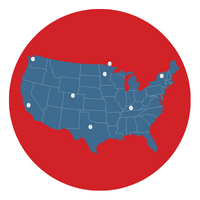TIP SHEET
How to Manage Paid Leave
for Remote and Hybrid Workers
More people are working remotely than ever before, so it’s vital that employers have a comprehensive understanding of paid leave laws in the many jurisdictions where their employees work. Learn more about the basics of paid leave management for flexible work environments.

Know Your Employees’ Locations
It’s crucial that employers know their employees’ exact locations, especially for fully remote workers. That’s because many paid leave laws only apply to employees working in certain jurisdictions. Additionally, the growth of more flexible working arrangements has made it easier for employees to move locations without their employer’s knowledge. Make sure you have processes in place to accurately track your employees and ensure compliance with all relevant regulations.

Know Whether You’re a Covered Employer
The intricacies of paid leave management for remote and hybrid workers also involve knowing whether you’re a covered employer. Some paid leave laws only apply to employers of certain sizes. And even that can be complicated. As an example, for a law in Washington, the size of the employer is determined by taking the average number of employees over the last four completed calendar quarters on Sept. 30 of each year.

Track Hours Worked by Jurisdiction
What if you have an employee who works in a different state and only comes into the office once a month? Do you have individuals or larger teams who regularly travel to certain regions? Employers should ensure they are tracking the exact number of hours worked by jurisdiction, as many paid leave laws have a certain number of hours that must be hit before benefits are triggered.

Track Incremental Use Amounts
Alright, so you have a handle on where your employees are and what paid leave laws apply to whom. Now come the details. One of the more challenging parts of applying paid leave laws across jurisdictions is knowing the incremental use amounts—essentially the number of consecutive hours an employee may take under a specific law. These are different everywhere. Some laws allow two-hour increments. Others allow four. Some even allow one hour of leave to be used. Staying on top of it all is crucial, especially for companies with a lot of remote and hybrid workers.

Know the Eligible Reasons for Taking Leave
Some jurisdictions allow employees to take leave for any reason; not just for sick leave. In Nevada, for example, employees aren’t required to provide a reason to their employer when they want to take paid leave. You should know the eligible reasons for paid leave in every jurisdiction where your employees work.

Train Your Compliance Teams
Managing paid leave laws for remote and hybrid employees presents a major challenge, especially for large employers that operate nationally. Our final recommendation is to train your compliance teams to ensure they understand the intricacies of each law, know what’s required of you, the employer, and know the specifics of employee leave regardless of location.
Need help tracking paid leave laws, including those for remote and hybrid locations? GovDocs can help you simplify your paid leave program across all locations.
Copyright © 2024 GovDocs, Inc. GovDocs is a registered trademark of GovDocs, Inc. This content is intended for market awareness only. It is not to be used for legal advice or counsel.
